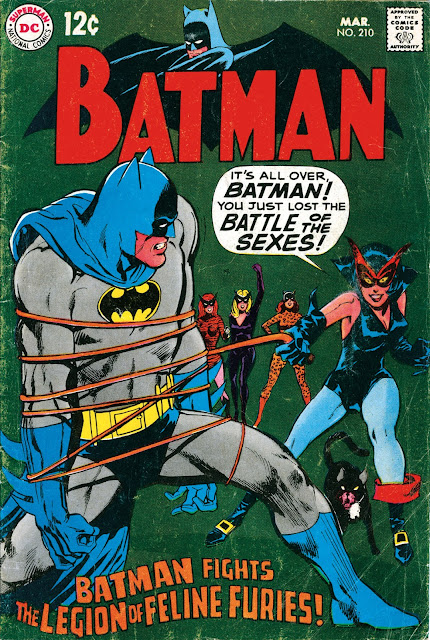 |
| © DC Comics. Detective #414. Cover by Neal Adams and Dick Giordano |
Of the three artists who defined the look of Batman in the 1970s - Neal Adams, Jim Aparo and Irv Novick, it is Irving H Novick who gets the least attention from fans. And yet he drew 107 Batman stories across the pages of Batman and Detective Comics during that period - far more than Neal Adams, and a production rate on a par with Jim Aparo.
Irv Novick was the artist at the helm as The Bronze Age for Batman started on 6th June 1968, with the publication of Batman #204 ("Operation Blindfold"), starting a fruitful partnership with Frank Robbins over the next two years.
 |
| © Batman #204. The start of The Bronze Age for Batman |
Robbins brought a crime caper story sense that he had honed on Johnny Hazard for two decades, but although Novick's artwork layout and perspectives were very innovative, the renditions of Batman were uninspired and relied too much on the more recent Silver Age depictions of Batman extant since the “New Look” premiered in 1964.
 |
| ©DC. Batman #204 "Silver Age style" |
Over the following months Novick continued in this style, inked by Joe Giella through to issue Batman #214, but with #215 the style changed radically, with Dick Giordano now inking. Batman was no longer drawn in a cartoony fashion.
 |
| © DC. A Panel from Batman #216 showing the transitional style |
Batman issue #217 cemented the new image of Batman as a loner, with Novick upping his game considerably to draw the pivotal “One Bullet Too Many” story which took Batman out of the Batcave, and Robin went off to college.
No doubt the change in illustration was driven by reader reaction to the Neal Adams version of the Batman present in Brave & Bold, but also I suspect that Novick was also smarting from having his cover to Batman #210 ("The Case of the Purr-Loined Pearl") redrawn by Neal Adams at short notice.
 |
| © DC. Irv Novick's original cover for Batman #210 |
 |
| © DC. Neal Adams' final cover for Batman #210 |
For my money, Novick’s best renditions of Batman were in Detective Comics #414, a story inspired by the movie Key Largo, again ably assisted by Dick Giordano on inks. The line work is the finest I ever saw on his work; the splash page showing Batman in the rafters is worthy of Adams, and the renditions of Batman in action are exciting and full of energy.
 |
| ©DC. Detective #414 foreward page. Fine art work. |
 |
| © DC. Detective #414 splash page. Batman in the rafters. |
The story - written by Denny O’Neil - gives time over for quieter moments of discussion between the characters, and Novick brings his “A” game in those moments as well, with a touch of Adams pastiche particularly in this image of "Loosy".
 |
| © DC. A reflective moment from Detective #414 |
Unlike Adams and Aparo, Novick rarely (if ever?) inked his own pencils, and without doubt his work when inked by Dick Giordano shone at its brightest. Other subsequent inkers like Frank McLaughlin demonstrated that Novick's style dominated and was not unduly influenced by different inkers, but that said, Giordano was without a doubt brought out the best in Novick's pencils.





































